A Comprehensive Guide to Different Pricing Strategies and Models
Studies show that increasing prices by just 1% can increase profits by more than 11%. Maybe that’s the answer to why some companies succeed while others fail, even in the same market. Pricing is directly connected with boosted profits.
Knowing the intricacies of pricing can be a game-changer, whether starting a new company or improving an old one. However, we’re there for you if you need to learn pricing strategies!
Come along on a journey to discover the strategies used by prosperous companies to succeed in a highly competitive market. Understanding pricing intricacies will help you attract customers, increase revenue, and build a stronger brand.
Together, let’s embark on this insightful journey to discover the tactics that can completely transform your company’s financial future.
Table of Content
- What is a Pricing strategy?
- The Importance of Choosing the Right Pricing Strategy
- Types of Pricing Strategies
- How to Choose a Pricing Strategy For Your Business?
- Pricing Models
- Difference Between A Pricing Strategy And A Pricing Model
- How to Create a Pricing Strategy?
- How to Conduct a Pricing Analysis?
- Benefits of an Effective Pricing Strategy
- Pricing Strategy Examples
- Focus on Implementing the Right Pricing
- FAQs
What is a Pricing strategy?
A pricing strategy captures the foundation of a company’s identity in the marketplace.
It is more than just a number; it is a complex combination of elements that combines creative and scientific accuracy. This approach captures the essence of a company’s services by striking the difficult balance between profitability and client happiness.
Businesses find the best price by looking at manufacturing costs. They also study how the market demand changes. And they examine the competition. This helps them discover the right price that will sell well.
This kind of art combines look and value. This greatly affects what consumers decide to buy and makes them loyal. It is also a science. It uses data-driven insights and follows market trends. This ensures the art is sustainable and competitive.
The key to success is deep knowledge of small market details and how customers behave.
Businesses use creativity and analysis to build their competitive position. They set prices that appeal to customers, make profits, and help them stay in the market for a long time.
The Importance of Choosing the Right Pricing Strategy
Any business’s choice of pricing strategy is of the utmost importance since it significantly impacts its finances, position in the market, and connections with customers.
The consequences are numerous: this decision will impact your company’s image, sources of income, and market placement.
A carefully designed approach can be the foundation for increased profitability, client loyalty beyond simple purchases, and boosting your brand’s fundamental worth.
A thoughtful pricing plan goes beyond simple calculation; it is a reflection of your company’s values and market knowledge.
It can determine whether your product is viewed as a high-end or low-cost choice, impacting sales and customers’ perceptions of your brand.
Additionally, it creates the conditions for consumer expectations, influencing their levels of satisfaction and desire for repeat business.
In the following sections, we will examine the variety of pricing techniques. Each one is complex and has benefits.
Understanding these small details will enable you to make well-informed decisions that effortlessly integrate your pricing strategy with your business objectives, guiding your company toward long-term success and positive client feedback.
Types of Pricing Strategies
Consider various pricing strategies, including value-driven and competitor-based ones, and their effects on achieving a balance between profit, customer satisfaction, and brand strength.
1. Competition-Based Pricing Strategy
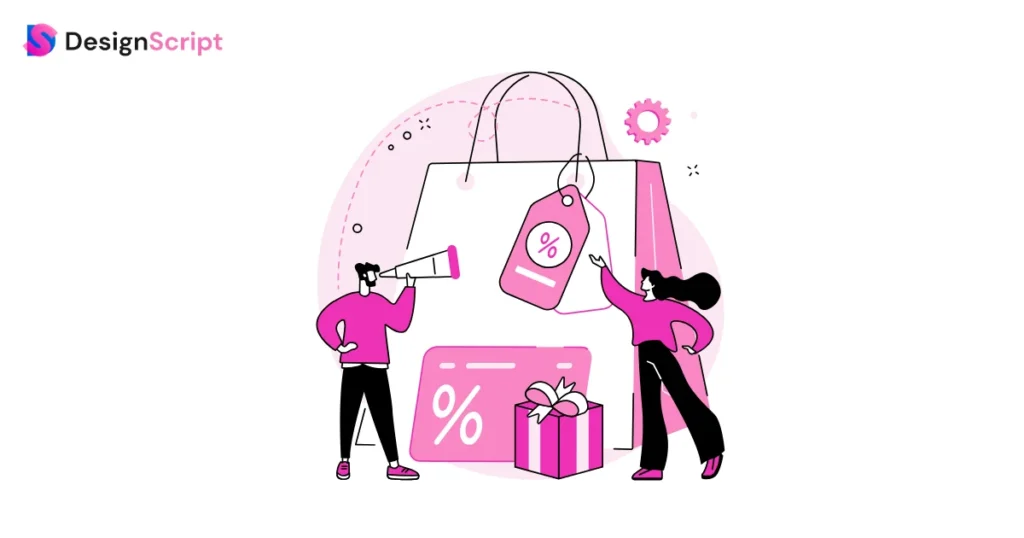
A common approach is to set prices with those of competitors. Although it guarantees competitiveness, focusing only on this strategy might not correctly reflect the value of your product.
Customers are demanding; they look for solutions that are not only reasonably priced but also high-quality and unique from the competition. Therefore, copying competitors entirely may result in undervaluation or missed chances to emphasize your product’s unique features.
2. Cost-Plus Pricing Strategy
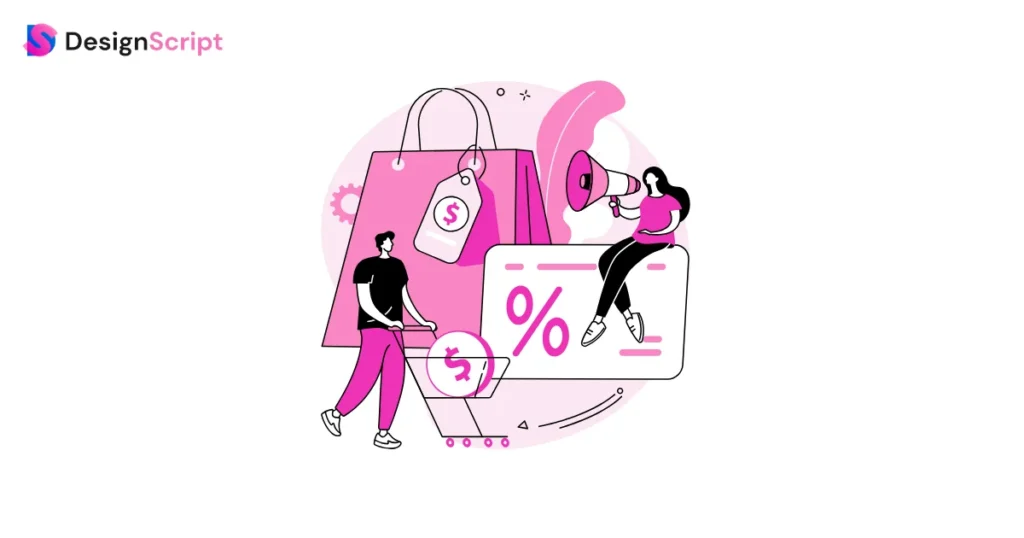
A layer of protection is created by calculating costs and adding a profit margin, ensuring that costs are met and profits are realized.
This approach, though, might be too narrow. Market demands and production costs aren’t always in line. Missed opportunities can result from failing to consider what the market will pay.
Flexibility is essential in a dynamic market. If your product has special advantages that make clients willing to pay more than just production costs plus a margin, a higher price may be acceptable.
3. Dynamic Pricing Strategy

Digital technology has made it possible for businesses to change prices in real-time thanks to the concept of dynamic pricing.
This approach recognizes the seasonal fluctuations of market demand and changes prices accordingly. Prices may increase during times of high demand, maximizing profitability.
On the other hand, when there is less demand, prices might decrease, attracting buyers who are on a tight budget. Businesses can maximize revenue by adapting to changes in the market, ensuring that their products remain both competitive and profitable.
4. High-Low Pricing Strategy

Pricing in the extremes produces a curious psychological dynamic.
Businesses can draw both price-sensitive clients looking for a deal and high-paying customers willing to pay more by setting initial pricing high and then offering discounts.
This approach profits from the excitement of closing a sale. However, if discounts become too frequent and predictable, it may require careful management to prevent compromise of brand value or frustration among consumers.
5. Penetration Pricing Strategy

Setting low beginning prices to quickly obtain market share is known as the cost of penetration, which is particularly helpful for new product introductions. By generating excitement, this tactic attracts early adopters and consumers who are price-conscious.
The goal is to gain an identity in the market, even though the early profits may be modest.
Prices can be continuously raised as a product acquires popularity and consumer loyalty over time.
Given that success is based on volume and client retention, this strategy demands a long-term perspective.
6. Skimming Pricing Strategy

Setting high initial costs and focusing on early adopters who are willing to pay more for the latest technology are both components of skimming pricing.
This approach takes advantage of some client segments’ desire to experience the latest developments first-hand.
Prices are gradually down to draw in a larger customer base. This technique enables companies to quickly recover their original investment money spent by capitalizing on the perceived value of innovation and uniqueness.
7. Value-Based Pricing Strategy

The basis for value-based pricing is the customer’s perception of the worth of a good or service. Along with production expenses, it also considers the advantages and enjoyment the product delivers.
If they believe they are getting more, customers are frequently willing to spend more. Understanding the special value propositions of your product can help you set premium prices and boost profitability by ensuring that costs reflect the advantages it offers.
With the help of this strategy, businesses may develop a pricing structure that accurately reflects the value that customers receive from their purchases.
8. Psychological Pricing Strategy
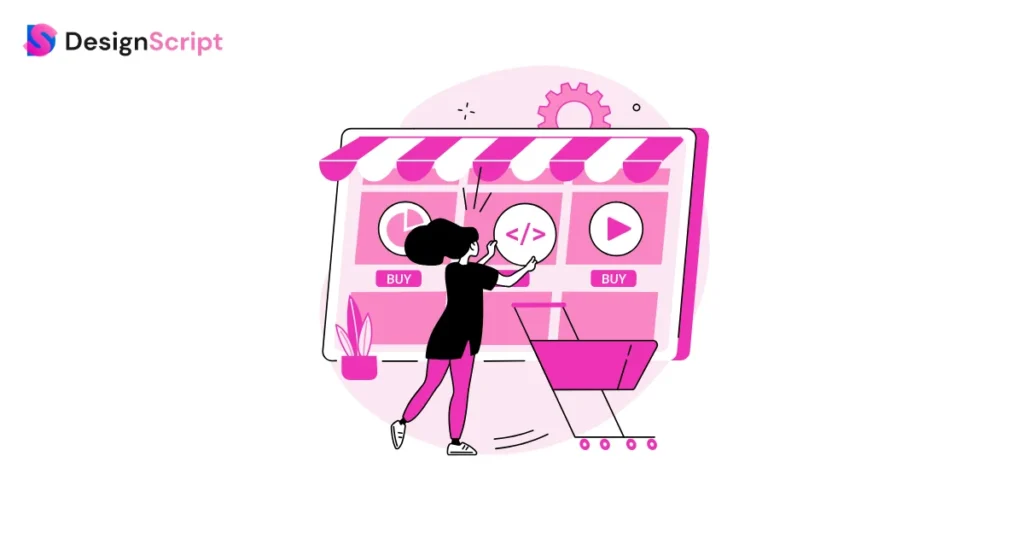
Considering the psychology of consumer behavior, psychological pricing. Pricing things just below a round figure, like $9.99 instead of $10, affects consumers’ minds.
Customers think the price is much lower even if there isn’t much of a change. The use of this strategy makes things seem more accessible and attractive by appealing to the emotional and subconscious parts of purchasing decisions.
It is a modest yet effective strategy to change customer impressions and increase sales.
9. Geographic Pricing Strategy
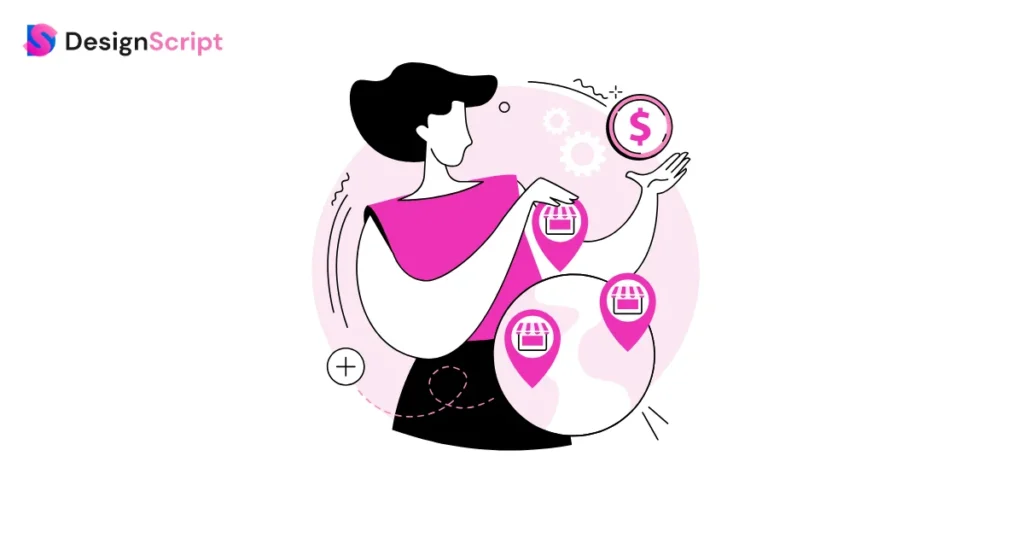
Geographic pricing considers the varying economic realities in various geographic areas.
To account for variations in purchasing power and economic circumstances requires adjusting prices based on geography.
This strategy guarantees that products continue to be competitive and cheap in various markets.
To determine the best rates that adapt to the unique demands and preferences of each place, businesses must study local economies, consumer behavior, and traditions.
For organizations, choosing an effective pricing strategy is essential since it serves as an effective tool to balance earnings and customer pleasure.
Cost-plus pricing, value-based pricing, penetration pricing, and skimming are various pricing strategies with their own merits and disadvantages. Understanding these small details and carefully mixing them to produce the best results is the art of pricing.
Businesses must perform market research, understand customer preferences, and assess opponents to make an informed decision. Furthermore, it must be done to do a thorough examination of production costs, value propositions, and market demand.
Companies may encourage customer loyalty, improve market presence, and maximize profitability by coordinating the pricing strategy with overarching corporate goals and making sure it connects with the intended audience.
This strategic approach to pricing not only improves financial performance but also fortifies the brand’s bond with its customer base, laying the foundation for long-term success and growth.
How to Choose a Pricing Strategy For Your Business?
Choosing the best pricing plan requires an in-depth understanding of important elements. It isn’t a general strategy; rather, it is specific to certain situations and emphasizes a thorough comprehension of several important aspects.
- Market knowledge is essential. Market analysis reveals competition tactics, demand trends, and consumer preferences.
- Cost comprehension is equally important. Production, distribution, and marketing costs are all considered in an accurate cost assessment, which makes sure that prices generate profits while covering all costs.
- Analyzing customer behavior reveals buying habits, tastes, and price sensitivity, assisting in the creation of pricing strategies that are in line with consumer preferences.
- Business goals are also essential. Do you want to build a premium brand, achieve continuous profitability, or quickly penetrate the market? Each objective necessitates a different price strategy.
- It is crucial to identify your target audience. Prices need to be in line with your clients’ purchasing preferences and financial capabilities.
Furthermore, it is crucial to comprehend the competitive landscape. Understanding the market’s standards by examining competitors’ pricing practices enables you to set competitive prices.
Carefully balance the Pros and Cons of each strategy before making a choice. Think about how each strategy fits with your knowledge of the market, your cost structures, and your research into customer behavior.
Consider how it complements your company’s goals and appeals to your target market. This thorough study gives you the knowledge you need to choose a pricing plan that not only achieves your short-term financial objectives but also assures long-term market success by encouraging sustainable growth and customer pleasure.
Pricing Models
Let’s examine some popular pricing models that influence how businesses determine how much to charge for their goods and services. Each model has its particular difficulties and benefits.
1. Premium Pricing: Elevating Value through Exclusivity
When a product is priced premium, it is similar to creating a masterpiece because the price represents not only the product’s actual value but also its limited availability and high quality.
Businesses using this strategy present their products as elite, attracting consumers who are eager to pay more for unmatched quality, great service, or unique characteristics.
Premium pricing is frequently used by luxury businesses, expensive technology, and handcrafted goods to project a sense of significance and improve the buying experience.
2. Hourly Pricing: Valuing Time and Expertise
Hourly pricing is a simple but efficient pricing strategy that is especially popular in service-oriented sectors. Clients are frequently charged for the number of hours that professionals, consultants, and freelancers spend on their assignments.
This model makes it clear and simple for both parties to grasp by guaranteeing a direct correlation between the service rendered and the payment received.
Clients appreciate this strategy’s clarity since they know they are paying for the precise time and skills invested in their project.
3. Bundle Pricing: Enhancing Value through Combinations
When various goods or services are grouped at a lower price than when purchased separately, bundle pricing is a purposeful dance of value that encourages buyers.
By utilizing the concept of perceived value, this approach encourages clients to investigate a larger range of services while realizing cost savings.
Bundle pricing is excellent for companies that provide complementary goods or services since it not only boosts sales volume but also develops customer loyalty by meeting a variety of needs in a single transaction.
4. Project-Based Pricing: Fixed Commitments, Consistent Outcomes
The very definition of consistency and predictability is project-based pricing. Businesses offer clients a transparent breakdown of expenses up front by proposing a set rate for the full job.
This method is frequently used in software development, creative sectors, and building projects since it allows for precise estimation of the work’s scope.
Customers value transparency and financial certainty because it helps them plan their budgets wisely and guarantees that businesses are fairly refunded for their knowledge and efforts.
5. Subscription Pricing: Cultivating Long-Term Relationships
Subscription pricing is a constant symbol of continuity and convenience in the digital era. Businesses regularly charge clients for their goods and services while providing them regularly.
This business model encourages long-term partnerships, guarantees reliable cash streams, and gives clients continuous access to critical services.
Subscription services help both businesses and customers. These services are in many industries. They include streaming, software, and food delivery. The consistent access they provide benefits both sides.
Pricing strategies are tools companies choose carefully. They depend on the products or services, customer needs, and business goals.
Businesses can create pricing plans to appeal to customers. This builds brand loyalty and supports steady growth. They can do this by understanding the unique features of pricing models.
An improved pricing strategy is not just a business choice. It shows your commitment to providing value, influencing customers, and building long-term relationships. This leads to lasting success in the ever-changing market.
Difference Between A Pricing Strategy And A Pricing Model
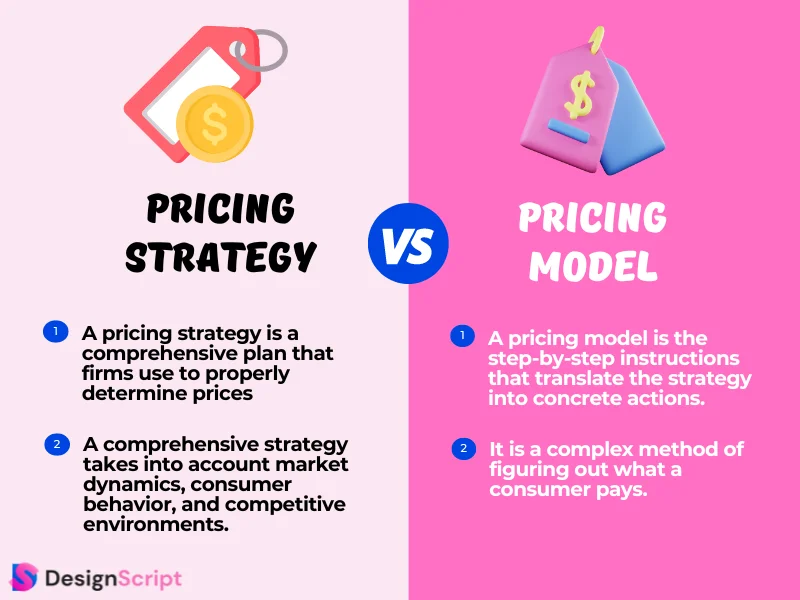
Understanding the difference between a price strategy and a pricing model is similar to mastering the choreography of a well-performed performance in the complex dance of business.
A pricing strategy is a comprehensive plan that firms use to properly determine prices.
It takes a comprehensive strategy, taking into account market dynamics, consumer behavior, and competitive environments. The business uses this strategy as a compass to steer it through the wide sea of pricing choices.
A pricing model, on the other hand, is the precise dance routine, the step-by-step instructions that translate the strategy into concrete actions. It is a complex method of figuring out what a consumer pays.
Similar to how different dancing styles are suited to various musical genres, different pricing structures are made to fit particular goods, services, and customers. Hourly price, for instance, can be the classy dance ideal for consulting services, while subscription pricing might be the lively tango ideal for software as a service (SaaS) goods.
Significantly, the price strategy directs the motions of the pricing model like a choreographer. It guarantees alignment between the company’s goals and its pricing strategy. For instance, if a company is interested in entering the market, the strategy can recommend a pricing approach called penetration pricing, and the model might involve establishing low beginning prices to attract a large customer base.
This alignment makes sure that every pricing choice is in line with the overall business objectives, resulting in a smooth, powerful performance between strategy and model in the marketplace.
When these factors work together, a company may persuasively communicate its value to customers, building a captivating story that resonates, encouraging customer loyalty, and advancing the company toward long-term success.
How to Create a Pricing Strategy?
A methodical and thoughtful approach is necessary to successfully negotiate the maze-like complexity in the complicated world of pricing strategies. It takes a comprehensive analysis that incorporates information from several perspectives to develop a pricing plan that aligns with your business goals and customer expectations.
1. Evaluating Pricing Potential: Analyzing the Core Variables
A thorough assessment of your product’s pricing potential is the fundamental component of any successful pricing plan. This begins with a thorough cost study that includes not only production costs but also costs for distribution, marketing, and operations.
Understanding your financial spending details is really important. It helps make sure your prices give you a profit and cover all your expenses. Investigating market demand is crucial as well. The worth of a good or service is closely related to how much people are willing to pay for it.
You can learn more about consumer needs, preferences, and purchase trends by doing a market analysis. Your ability to choose pricing that corresponds with the market’s willingness to pay will help to maintain the competitiveness and appeal of your offerings.
2. Perceived Value: The Heart of Pricing
The invisible thread that runs through client views is perceived value. The value your product contributes to the lives of your clients is more important than just what it does. Put yourself in your client’s position to determine this.
What special advantages does your product provide? How does it meet a need or resolve a problem? You can determine how much customers are willing to pay for these benefits by knowing how your product is viewed to be worth.
This knowledge is priceless because it helps you to set pricing that reflects the perceived value of your products in the eyes of your clients.
3. Understanding Buyer Personas: Tailoring Prices to Preferences
Your consumers are not uniform groups; they are unique people with different tastes, means of support, and demands. Customer base segmentation is made easier by creating buyer personas.
Recognize their ages, lifestyles, and shopping preferences. What are their problems, and what kind of value are they looking for? You can adjust your pricing to appeal to various customer categories by thoroughly understanding your target.
For instance, price-sensitive clients may value discounts or package deals, while those who value premium features may be willing to pay a higher price.
4. Analyzing Historical Data: Learning from the Past
Historical data analysis is a rich source of knowledge about the past. Analyze historical sales data and consumer trends. Recognize trends, patterns, and seasonality.
Did particular pricing techniques lead to more sales? Did promotions during particular times increase patronage?
Data from the past offers a road map of what was successful and unsuccessful. These insights inform your price choices in the future, allowing you to profit from productive techniques and prevent making the same mistakes twice.
5. Striking a Balance: Value, Brand Image, and Revenue Goals
Pricing is more than simply a matter of numbers; it also involves coordinating your products with your brand’s image and overall company goals. Your prices should be in line with your brand positioning and represent the value you offer.
Your pricing should reflect the limited availability of your brand if it is associated with high-end products. Your prices must simultaneously strike a balance between the worth of your customers and your revenue targets.
This balance guarantees long-term financial success while sustaining client happiness and creating lasting bonds.
6. Competitor Pricing: Learning from the Market Landscape
Knowing how your rivals set their prices for comparable goods or services is like having a pulse on the market in the fast-paced world of business. Examine their strategies.
Do they use premium pricing to promote exclusivity? Are they using penetration pricing to gain a large market share quickly? Although you don’t have to adopt their strategies, being aware of them offers helpful insights.
It enables you to competitively position your pricing, ensuring that your solutions are appealing in the context of the market.
Your pricing plan will be more durable and flexible if you incorporate these detailed evaluations.
How to Conduct a Pricing Analysis?
Any business strategy must include a pricing study, which is a thorough analysis of many market factors to establish the best price for goods or services. This multi-dimensional process thoroughly analyzes consumer behavior, market trends, and competition pricing strategies.
Businesses can make wise selections by researching these topics and ensuring that their products remain competitive and provide financial returns.
Analyzing market trends entails observing changes and trends in customer preferences and purchase patterns. Understanding these trends enables firms to match their pricing plans with market demands. It offers insightful information about what customers are prepared to pay for a particular good or service.
By monitoring these changes, companies can efficiently change their pricing structures to match changing client needs.
Analyzing customer behavior digs into the psychology behind consumer purchase choices. Customer behavior is heavily influenced by price sensitivity, perceived value, and willingness to pay.
Businesses can obtain a thorough grasp of their client’s preferences through surveys, focus groups, and data analytics. This information can help businesses determine the ideal pricing points that appeal to clients while balancing cost and perceived value.
Analyzing rival pricing includes carefully examining their pricing approaches. Businesses can successfully position their items in the market by comparing them against rivals.
This analysis helps in locating price discrepancies, understanding the factors influencing rivals’ pricing strategies, and discovering the differentiating qualities of products in the market.
With this knowledge, companies can modify their pricing strategies to obtain a competitive advantage, whether by charging less, including more features, or bundling services.
The ultimate objective of a pricing study is to determine appropriate price points. This involves achieving a balance between maximizing earnings and preserving market competitiveness.
Thanks to data-driven insights from industry trends, consumer behavior, and rival pricing, businesses may make wise decisions. By optimizing prices, companies can grow market share, draw in more customers, and eventually boost their profitability.
Pricing analysis is an ongoing, dynamic activity. To keep ahead of the competition, businesses must be watchful, analyze market trends, and change their pricing strategy.
Comprehensive pricing assessments can help businesspeople navigate uncertain markets, adapt to shifting customer expectations, and ultimately achieve sustainable corporate success.
Benefits of an Effective Pricing Strategy
- Increased Profitability
A strong pricing strategy is the foundation of a flourishing company, providing a wealth of benefits that extend far beyond financial profits. Increased profitability is one of the most noticeable advantages of a thoughtful pricing plan. Businesses can maximize their revenue streams by conducting a thorough market analysis, comprehending consumer behavior, and intelligently setting prices. Profitability allows the business to continue operating and gives it the means to innovate and grow.
- Targeted Customer Segments
A carefully planned pricing strategy enables companies to target particular client categories successfully. Companies can draw a wide variety of customers by adjusting prices to meet the needs and tastes of various customer groups. This targeted strategy increases sales within each category. It promotes customer satisfaction since people believe the pricing structure aligns with the worth of the goods or services they receive.
- Higher Sales Volume
A pricing plan that works well also has the important benefit of increasing sales volume. Businesses may increase demand, encourage repeat business, and gain market share by striking the correct price-value balance. Along with increasing revenue, this increased sales volume also strengthens economies of scale, resulting in lower production and distribution costs.
- Stronger Market Position
A successful pricing plan also improves a company’s position in the market. It helps the company set itself out from rivals in the market by establishing a distinctive character. This differentiation may be based on elements like the caliber of the product, the level of customer service, or special selling points, all of which are strongly related to the perceived cost value.
- Enhance Brand Value
The significant benefit is increased brand value. Fair and consistent pricing helps build trust with customers. Even if competitors have lower costs, customers prefer to stay with a brand they trust. This loyalty leads to repeat sales, long-term client relationships, and positive word-of-mouth. All of these have a big, positive impact on a business’s profits.
A good pricing strategy is a useful tool. It helps create a positive market image. It also builds customer loyalty and drives financial success. Companies can use price to build a sustainable and successful future. To do this, they need to understand the market, customer preferences, and the competition.
In summary, a successful pricing strategy is a complex tool that develops a positive market image, fosters consumer loyalty, and drives financial success. Businesses can use the power of price to build a sustainable and successful future for their companies by understanding the dynamics of the market, client preferences, and the competitive landscape.
Pricing Strategy Examples
A few big companies have gotten really good at figuring out how to set prices in the tough world of business. They’re setting the standard for companies all over the world. These giants have pricing strategies based on their brand, customer base, and goals. This influences their dominance and client retention.
1. Apple: Skimming Pricing Strategy
Apple is known for uniqueness and innovation and they use the skimming price approach. Apple sets a high price for new products like the latest iPhone or MacBook. This attracts tech-savvy early buyers looking for top-notch features and quality items.
Using fans’ eagerness to be the first to try their innovations, Apple can make the most money at first. Apple lowers costs for wider clientele, maintains reputation for quality as demand stabilizes.
2. Amazon: Dynamic Pricing Strategy
Amazon, the reigning supreme of e-commerce, uses a dynamic pricing strategy. It quickly modifies its prices by closely observing changes in demand and competition pricing.
Prices may rise somewhat during times of high demand, such as holidays or special events, to capitalize on increased demand. In contrast, prices are reduced during times of low demand to appeal to consumers on a tighter budget.
Amazon uses complex algorithms to keep prices on their products competitive while maximizing sales and guaranteeing customer pleasure by providing the greatest offers.
3. Netflix: Subscription Pricing Strategy
With its subscription-price model, Netflix’s streaming service changed the entertainment sector. Netflix offers clients unrestricted access to a sizable content library through monthly subscriptions.
This strategy guarantees a consistent and predictable revenue stream, resulting in the company’s financial stability. The ease and adaptability of this strategy, which enables subscribers to binge-watch their preferred shows without the inconvenience of individual
subscribers value purchases.
This strategy has changed how people consume entertainment worldwide, and Netflix has become a popular name.
4. Walmart: Everyday Low Pricing Strategy
The supermarket chain Walmart routinely offers low prices. This tactic draws price-conscious clients who prefer affordable options. Walmart maintains constant low pricing throughout its broad assortment of goods.
Customers trust Walmart because they know they can always find affordable products. Walmart can keep prices low and make money because it’s really big and runs well.
This strategy has solidified Walmart’s status as the preferred choice for millions of budget-conscious buyers.
Focus on Implementing the Right Pricing
Choosing the right pricing strategy is a crucial decision for any business. It can impact your profitability, brand image, and customer loyalty. By understanding the different pricing strategies and models available, you can create a plan that aligns with your business goals and target market.
Remember, there is no one-size-fits-all approach to pricing. The best strategy for your business will depend on various factors, including your product or service, your target market, and your competition. Carefully consider all of these factors and conduct thorough market research before deciding.
By developing a well-crafted pricing strategy, you can set your business up for long-term success. This will allow you to attract new customers, retain existing ones, and achieve your financial goals. So don’t underestimate the power of pricing – it can be a powerful tool for driving business growth.
FAQs
Achieving the ideal pricing requires balancing perceived value, industry norms, market demand, and production costs. By matching these aspects, businesses may effectively interact with clients and assure revenue.
Although they draw consumers, discounts can hurt profit margins and perceived value. Careful planning preserves brand loyalty and profitability, but hasty discounting can lead to disastrous pricing wars. Reducing costs without sacrificing profitability is essential for long-term company expansion.
Businesses can create customized pricing plans by considering customers’ preferences and willingness to pay. This customized strategy increases consumer satisfaction and brand loyalty while matching pricing decisions to market demands.

